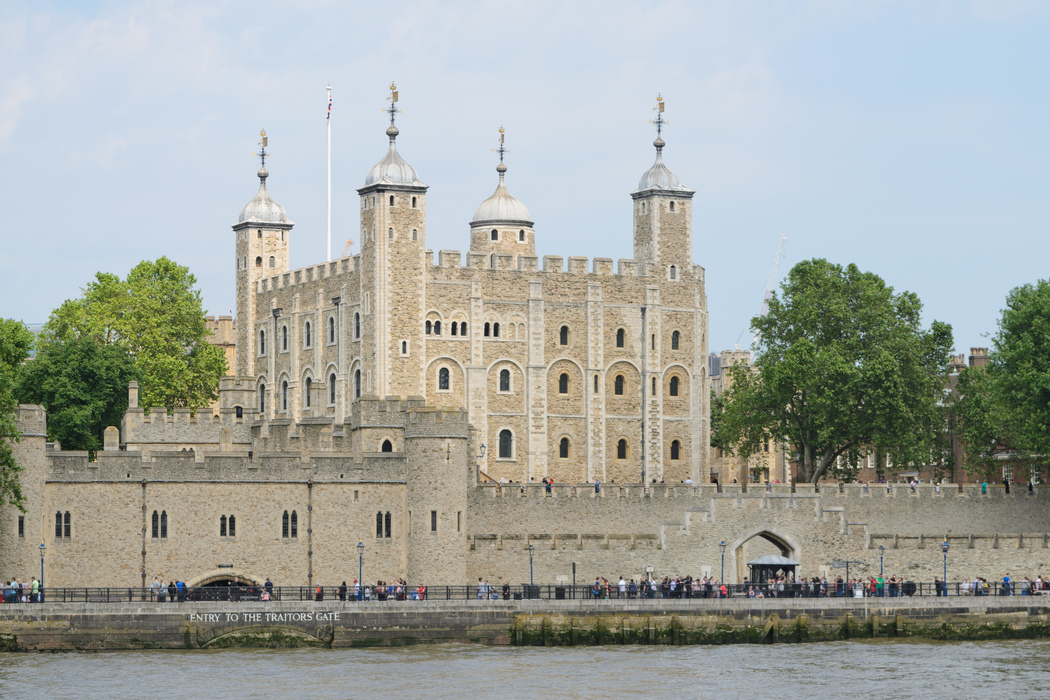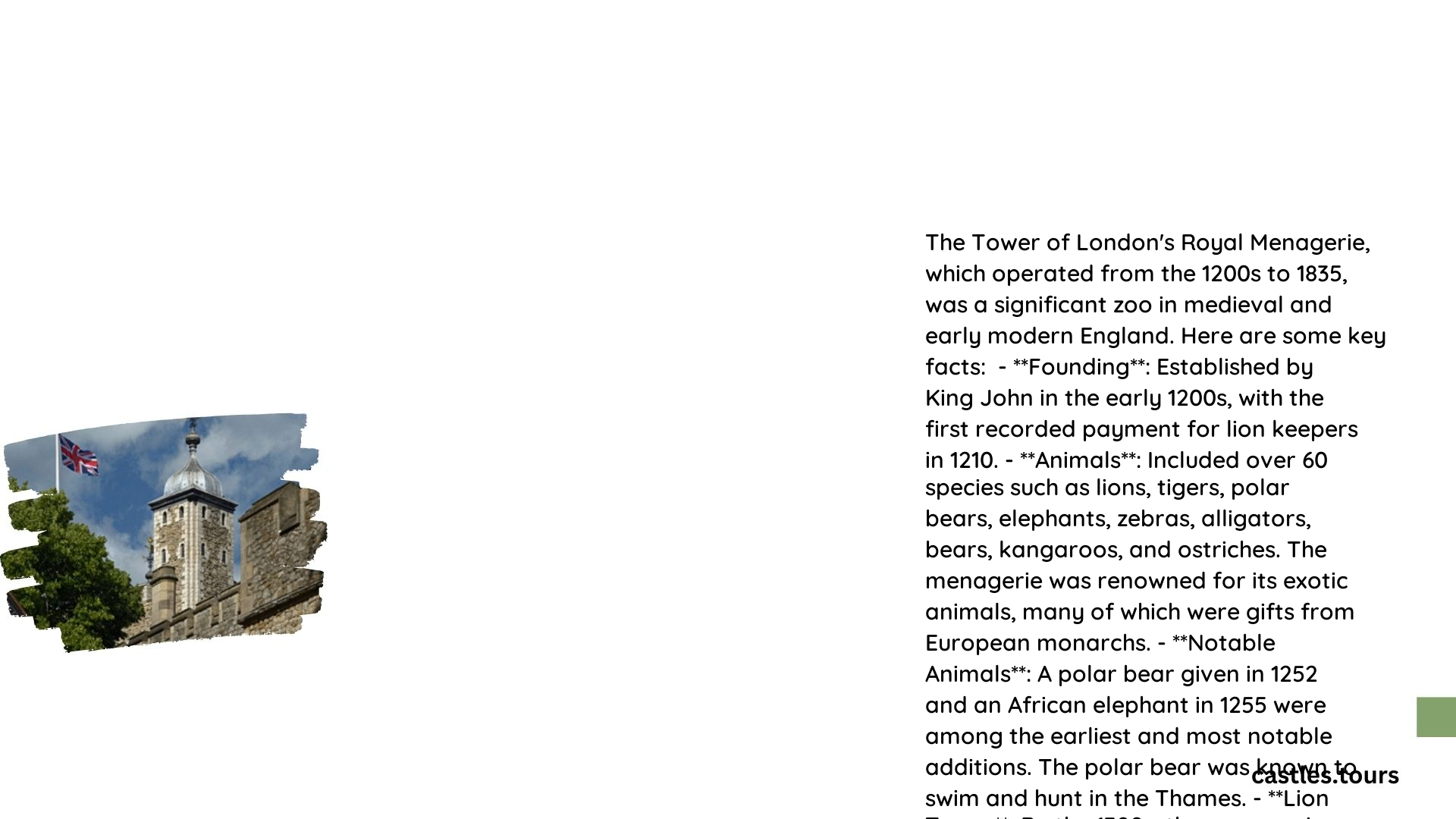The Tower of London Zoo, officially known as the Tower of London Menagerie, was one of Europe’s earliest and most renowned animal collections. Operating from the 1200s to 1835, it served as a symbol of royal power and a public attraction. This royal menagerie housed exotic animals from around the world, including lions, leopards, polar bears, and elephants, showcasing the crown’s wealth and global connections.
What Was the Origin of the Tower of London Zoo?

The Tower of London Menagerie traces its roots to the early 13th century. Key milestones in its establishment include:
- 1235: The first lions arrive, gifted by Frederick II of the Holy Roman Empire to Henry III.
- 1252: A polar bear joins the collection, causing a sensation among Londoners.
- 1255: An African elephant arrives, further expanding the exotic animal roster.
- 1270s: Edward I relocates the menagerie to the Tower’s entrance, creating the iconic Lion Tower.
This royal collection quickly became a symbol of the monarchy’s power and global reach, housing animals from far-flung corners of the world.
Which Animals Were Housed in the Tower of London Zoo?

The Tower of London Menagerie boasted an impressive array of exotic creatures throughout its history. Here’s a table showcasing some of the notable animals:
| Animal | Year of Arrival | Significance |
|---|---|---|
| Lions | 1235 | First animals in the menagerie |
| Polar Bear | 1252 | Caused a sensation; allowed to fish in the Thames |
| African Elephant | 1255 | First elephant in England since Roman times |
| Leopards | Various | Regularly featured in the collection |
| Tigers | 17th century | Added to the big cat collection |
| Wolves | Various | Part of the diverse mammal collection |
| Eagles | 17th century | Represented the bird collection |
| Kangaroos | Early 19th century | Exotic additions from Australia |
By 1622, the menagerie included:
– 11 lions
– 2 leopards
– 3 eagles
– 2 pumas
– 1 tiger
– 1 jackal
Under Alfred Cops’ management in the 1820s, the collection expanded to around 300 animals from 60 different species.
How Did the Tower of London Zoo Evolve Over Time?
The Tower of London Zoo underwent significant changes throughout its existence:
- Early Years (13th-16th centuries):
- Focus on large, impressive animals like lions and bears
- Limited understanding of animal care and needs
-
Primarily a private royal collection
-
Expansion Period (17th-18th centuries):
- Increased variety of species
- Growing public interest and limited access
-
Introduction of animal fights as entertainment
-
Professional Management (Early 19th century):
- Appointment of Alfred Cops as Keeper in 1822
- Improved animal care and living conditions
- Expansion to 300 animals from 60 species
-
Increased focus on breeding programs
-
Decline and Closure (1830s):
- Growing concerns about animal welfare
- Safety issues and animal escapes
- Competition from the newly established London Zoo
- Closure in 1835 and transfer of animals to London Zoo
What Were the Challenges in Animal Care at the Tower of London Zoo?
Animal care at the Tower of London Zoo faced numerous challenges:
- Limited Knowledge: Early keepers had little understanding of exotic animal needs.
- Inadequate Diets: Animals often received inappropriate food, like the elephant given daily wine.
- Confined Spaces: Many animals were kept in small, unsuitable enclosures.
- Harsh Climate: The English weather was unsuitable for many tropical species.
- Public Interaction: Visitors sometimes harassed or fed animals inappropriately.
- Disease: Close quarters and poor hygiene led to frequent illnesses.
It wasn’t until Alfred Cops’ tenure in the 1820s that significant improvements in animal care were implemented.
What Was the Legacy of the Tower of London Zoo?
The Tower of London Zoo left a lasting impact on zoological history:
- Precursor to Modern Zoos: It set a precedent for public animal exhibitions.
- Scientific Contributions: Under Cops’ management, it contributed to animal breeding and care knowledge.
- Cultural Impact: The menagerie influenced literature, art, and public perception of exotic animals.
- London Zoo Foundation: Many animals were transferred to the newly established London Zoo, contributing to its initial collection.
- Historical Significance: It remains an important part of the Tower of London’s rich history.
Today, the Tower commemorates its menagerie history with wire sculptures of former animal inhabitants, allowing visitors to imagine the once-bustling royal zoo.
How Did the Tower of London Zoo Compare to Modern Zoos?
The Tower of London Zoo differed significantly from modern zoos:
- Purpose: Primarily a symbol of royal power rather than conservation or education.
- Animal Welfare: Limited understanding of animal needs compared to today’s standards.
- Enclosures: Small, often inadequate spaces unlike modern habitat-based exhibits.
- Public Access: Initially restricted, later becoming a public attraction.
- Educational Value: Limited focus on public education about animals and conservation.
- Research: Minimal scientific research compared to modern zoo programs.
- Conservation Efforts: No formal conservation programs as seen in contemporary zoos.
Despite these differences, the Tower of London Zoo played a crucial role in developing public interest in exotic animals and laid the groundwork for future zoological institutions.
References:
1. https://www.hrp.org.uk/tower-of-london/history-and-stories/the-tower-of-london-menagerie/
2. https://www.historyhit.com/lions-and-tigers-and-bears-the-tower-of-london-menagerie/
3. https://historynavigator.org/2018/03/04/the-animals-in-the-tower-a-brief-history-of-the-royal-menagerie/
